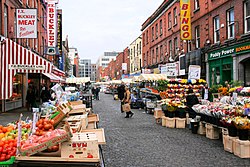This article has multiple issues. Please help improve it or discuss these issues on the talk page . (Learn how and when to remove these messages)
|


A street market or open-air market [1] is a market that is set up on certain days of the week, generally on the street in open-air places; they are usually located in public places or ceded by the town council of the locality such as squares, avenues, parking lots, etc. However, it can traditionally be set up in a market square or in a market town such as Camden Town. [2]
Contents
This type of marketplace, has very different forms around the world, given the great variability of facilities and products offered. According to the 2015 yearbook of La Caixa, in Spain there were officially registered 17,999 street markets. [3]


